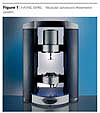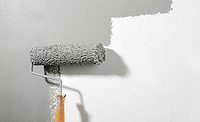
Comprehensive and high-precision rheological measurements that provide information about shelf life, processability and sagging/running characteristics, are essential if innovative and high-quality paints are well positioned in the marketplace. Parameters such as the yield stress and thixotropy must be measured precisely. Such comprehensive material investigations require a rheometer that measures in different modes such as controlled rate (CR), controlled stress (CS) and controlled deformation (CD).
Various levels of shear rates arise during the production, transport and processing of paints. The paint's viscosity at a given rate is measured in Controlled Rate (CR) mode.
From a technical standpoint, measurements that determine shelf life and running characteristics are much more challenging. The influence of the gravitational force is represented by very small shear stresses. Rheometers that measure the smallest possible shear stresses produced in Controlled Stress (CS) mode are needed for this purpose. The same applies to measuring the yield stress, which should be determined using a CS ramp as defined in DIN report 143. Creep tests are also undertaken in CS mode.
The curing characteristics of paints are measured in oscillation tests. The sine-shaped oscillation tests have very little amplitude in CD or CS and, therefore, do not influence the material.
A universal rheometer with air bearings is needed to be able to take all the measurements required in CR, CS and CD mode. Universal rheometers are available (Figure 1) that can deliver high-precision measurements at the lowest of shear stresses and are especially suited to measuring zero shear viscosity and small yield stresses.
For complete rheological characterization of paints, the extensional properties also have to be measured. These properties have a considerable impact on processes such as filling and spraying.

Thixotropy
Thixotropy flow behavior is the decrease of viscosity as a function of time under shear and the recovery of the structure as a function of time without shearing. Thixotropic agents are added to influence the structural formation of a paint. They play a crucial role in how the paint behaves depending on the shear stress during application (running characteristics). Optimizing the thixotropic agent ensures a smooth surface and prevents drips from forming, even when using greater layer thicknesses.In order to show the effect of two different thixotropic agents, two paint systems (A and B) were investigated. The measurements were taken at a temperature of 23 °C using a cone/plate measurement geometry out of titanium with a diameter of 35 mm and 2° angle of cone. A Pelletier temperature control unit was used.
Thixotropic loops are measured in CR mode. These consist of one flow curve measured upwards and one measured downwards as well as an intermediary waiting time at maximum shear rate. The enclosed hysteresis area is a common measure for the rheological effect of thixotropic agents (Figure 2).
The speed of structural formation plays a central role in paint's running characteristics. This can be calculated in what is commonly referred to as a shear recovery test. After shear stress (corresponding to applying the paint), the increase in viscosity over time is measured. The sample must be stressed as little as possible in the recovering test so that the structures forming are not destroyed by the measurement.
In principle, the structural formation can be measured in CR or CS mode or in oscillation. All three modes were used to discover which mode allowed the paints used (A and B) to best be distinguished in the shear recovery test. Every measurement job consisted of two measurement segments. In the first segment, the structure was broken down in CD mode using 100 1/s for 60 s. In the second segment, the structural formation was measured in CR mode using a shear rate of 0.5 1/s, in CS mode using a shear stress of 1 Pa and in oscillation using an angular frequency of 10 rad/s and a shear stress of 1 Pa.

Differences in Structural Formation
The characteristics in the structural formation of paints A and B differ considerably more over time in CS mode than in CR mode (Figure 3). This indicates that even a low shear rate of 0.5 1/s limits the structural formation of this paint system, while a shear stress of 1 Pa allows for greater structural formation. This also proved to be the case for other coatings.
If you consider the viscosity of the structural formation measured during oscillation, the two paint samples show no great differences (Figure 3). If instead parameter G' is used as the measure for elastic characteristics and parameter G" as the measure for viscous characteristics, significant differences can be seen between samples A and B (Figure 4).

Results at a Glance
For more information, visit www.thermo.com/mars, or call +49 (0) 721 4094 444.




Report Abusive Comment